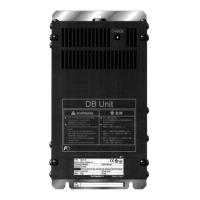■ Vertical lift load
A simplified mechanical configuration is assumed as shown in Figure 10.3-2. If the mass of the cage is W
0
(kg), the
load is W (kg), and the balance weight is W
B
(kg), then the forces F (N) required for lifting the load up and down are
expressed as follows:
For lifting up
(Equation 10.3-6)
Assuming the maximum load is W
max
, the mass of the balance weight W
B
(kg) is generally obtained with the
expression W
B
= W
O
+ W
max
/2. Depending on the mass of load W (kg), the values of F (N) may be negative in both
cases of lifting up and down, which means the lift is in braking mode. So, be careful in motor and inverter selection.
For calculation of the required output torque τ around the motor shaft, apply the expression (Equation 10.3-1) or
(Equation 10.3-2) depending on the driving or braking mode of the lift, that is, apply the expression (Equation
10.3-1) if the value of F (N) is positive, and the (Equation 10.3-2) if negative.
Figure 10.3-2 Vertical Lift Load
■ Inclined lift load
Although the mechanical configuration of an inclined lift load is similar to that of a vertical lift load, non negligible
friction force in the inclined lift makes the difference; in an inclined lift load, there is a distinct difference between the
expression to calculate the lift force F (N) for lifting up and that for lifting down.
If the incline angle is θ, and the friction coefficient is μ, as shown in Figure 10.3-2, the driving force F (N) is
expressed as follows:
For lifting up
(Equation 10.3-8)
The braking mode applies to both lifting up and down as in the vertical lift load. And the calculation of the required
output torque τ around the motor shaft is the same as in the vertical lift load; apply the expression (Equation 10.3-1)
if the value of F (N) is positive, and the (Equation 10.3-2) if negative.
Figure 10.3-3 Inclined Lift Load

